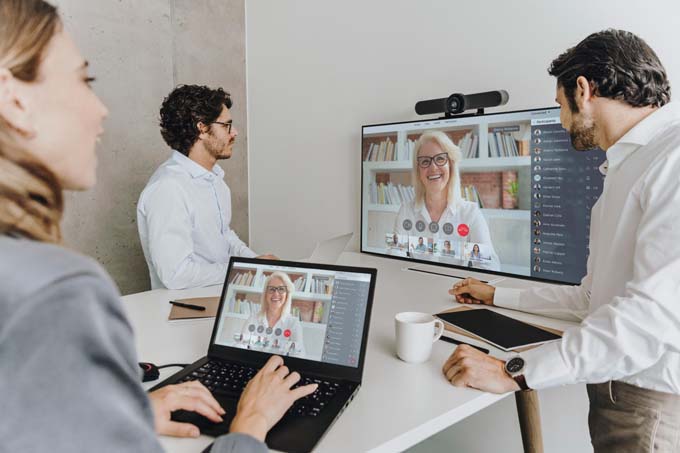Improve hybrid work models and back to the office
A global study by Barco ClickShare shows that employees have a strong desire to return to the office. At the same time, they expect their employer to invest in technologies that facilitate hybrid working models according to COVID-19.

Barco, a leading provider of visualization and collaboration solutions, has published a new large-scale study. It reveals some surprising results about what employees around the world expect from the workplace in the wake of the COVID 19 pandemic. The study - which surveyed 1,750 employees worldwide (250 each from the United States, United Kingdom, France, Germany, Australia, India and the United Arab Emirates) through global research panel provider Dynata - found that only 15% of employees plan to continue working full-time from home after COVID-19 restrictions are lifted. Nearly half of respondents said they are less likely to want to work from home today than they were when the pandemic began. They cited challenges collaborating with colleagues, difficulty collaborating in meetings, and a lack of the social component of office life as the main reasons for their desire to return to the office. Instead, employees want hybrid work models. In these models, most time is spent in the office, but employees also have the flexibility and freedom to work from home when it works best for them. The survey found that the ideal balance is a global average of 3 days in the office, with a maximum of 2 days per week working remotely.
The home office has lost its luster
The survey results suggest that many employees have been negatively impacted by being away from their colleagues - both emotionally and in their work. Globally, 49% said they have found working from home less enjoyable over time. 37% said they found it harder to collaborate when working remotely. 29% said it is difficult for them to contribute at meetings when they are virtually connected. 28% said they are more easily distracted at home.
Not surprisingly, collaboration and social contact were the main reasons people wanted to return to the office: 45 % said they found it easier to work with colleagues in the office. The same proportion said they liked the social aspect of office life. Thus, 44% emphasized the importance of spontaneous encounters.
Hybrid work models will entail office transformation
According to the study, most employees believe that the world of work will return to some sort of normalcy after COVID-19. However, hybrid meetings, where one part of the workforce is connected virtually and the other part participates from the office, will become the norm. After a huge trend in recent years toward environments for impromptu meetings, known as huddle spaces, the results suggest that these areas may be on the way out. 50% of respondents said they preferred formal meeting spaces. 75% prefer scheduled meetings to impromptu meetings.
Surprisingly, employees seemed very strongly opposed to the idea of spending more time in satellite offices or collaboration spaces - a trend many had predicted as a result of the pandemic. Most employees still prefer to spend most of their time in a large corporate headquarters. However, with more flexibility than before to work from home some of the time.
Video conferencing is the heartbeat of business collaboration
The respondents to the study would most like to see new investments in video conferencing equipment for meeting rooms. The results may seem surprising at first glance, but the use of video conferencing technology is now widespread. The technology plays a fundamental role in the collaboration, communication and productivity of a digital and modern workforce.
After traditional meeting rooms, video conferencing rooms are the most frequently used rooms in the office. 77% of respondents said they use video conferencing rooms at least once a week, with an average of 28% using them daily.
The laptop becomes more important for employee communication and participation
The "Bring Your Own Meeting" trend that was growing prior to COVID-19 - where employees use not only their own devices, but also their own preferred conferencing solutions - has continued to grow during the pandemic. Indeed, the results of the study show that the laptop is now the most important device for most employees at work: 77% said they could not work without a laptop while at work.
Despite the increase in the use of room cameras (traditional in-room conferencing systems and USB-based SWAPs) from 30% to 40% in one year, laptop cameras are still the most commonly used for virtual meetings. 54% use their laptop camera, compared to 40% who use room cameras and 24% who use their smartphone camera. At the same time, more than 60% of respondents complain about interference with their cameras during meetings.
Technological change will lead to further improvements in meetings
Nearly half of the employees surveyed felt that the frequency of meetings had increased over the past year. Although much frustration was expressed around virtual meetings during the lockdown, overall, respondents felt that the quality of meetings has improved over the past 12 months. Nearly twice as many people expect meetings to have improved, rather than worsened.
Employees have high expectations for technology improvements in future meetings. The biggest priorities are given to technologies that increase efficiency and ease of use and simplify workflows. 56% said apps for participating in a one-click video conference should be available within the next year if they are not already. In addition, most people expect voice recognition technology, collaboration software and Instagram-like filters for video conferencing within two years.
Hybrid work models require more technology
This underscores the need for meeting technologies to enable more connectivity between physical and virtual participants in the future. For example, six in ten cite a lack of face-to-face interaction with colleagues as one of the top reasons for being less connected to their co-workers. 49% said that remote collaboration with colleagues, customers and others is not a given. If technology can help foster better connectedness through hybrid and virtual meetings, for example, we will continue to see an increase in the quality of meetings.
Source: Barco









